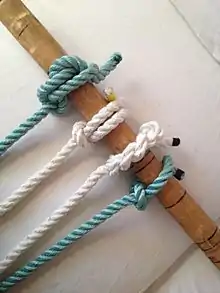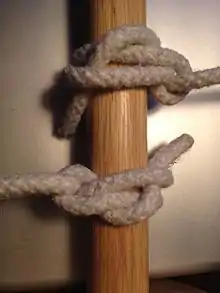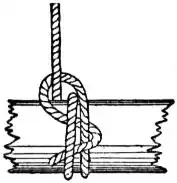Halyard bend
Studding-Sail Bend[2] is a way to attach the end of a rope at right angle to a cylindrical object such as a beam.

Halyard bend (upper left), timber hitch (lower right)

Halyard bend
| Studding-Sail Bend | |
|---|---|
 | |
| Names | Studding-Sail Bend, Studding-sail Halyard Bend[1] |
| Category | Hitch |
| ABoK | #1678 |
Tying
- wrap the end two or more times around the object
- make the end hook around the standing part and under all wrappings, to come out by the last wrap
- make the end turn back and cross over the wrappings, to tuck/pass it under the first wrap
Halyard bend may be considered to be the "double-loop-around, and single-tuck-under" version of timber hitch which itself is usually tied as "single-loop-around, and double-tuck-under".
See also
- List of knots
- Topsail Halyard Bend
- Gaff Topsail Halyard Bend
References
- Encyclopædia Britannica (11th ed.), v. 15, 1911
- Ashley, Clifford W. (1944). The Ashley Book of Knots, Doubleday, p.291, #1678 ISBN 0-385-04025-3
External links
This article is issued from Wikipedia. The text is licensed under Creative Commons - Attribution - Sharealike. Additional terms may apply for the media files.